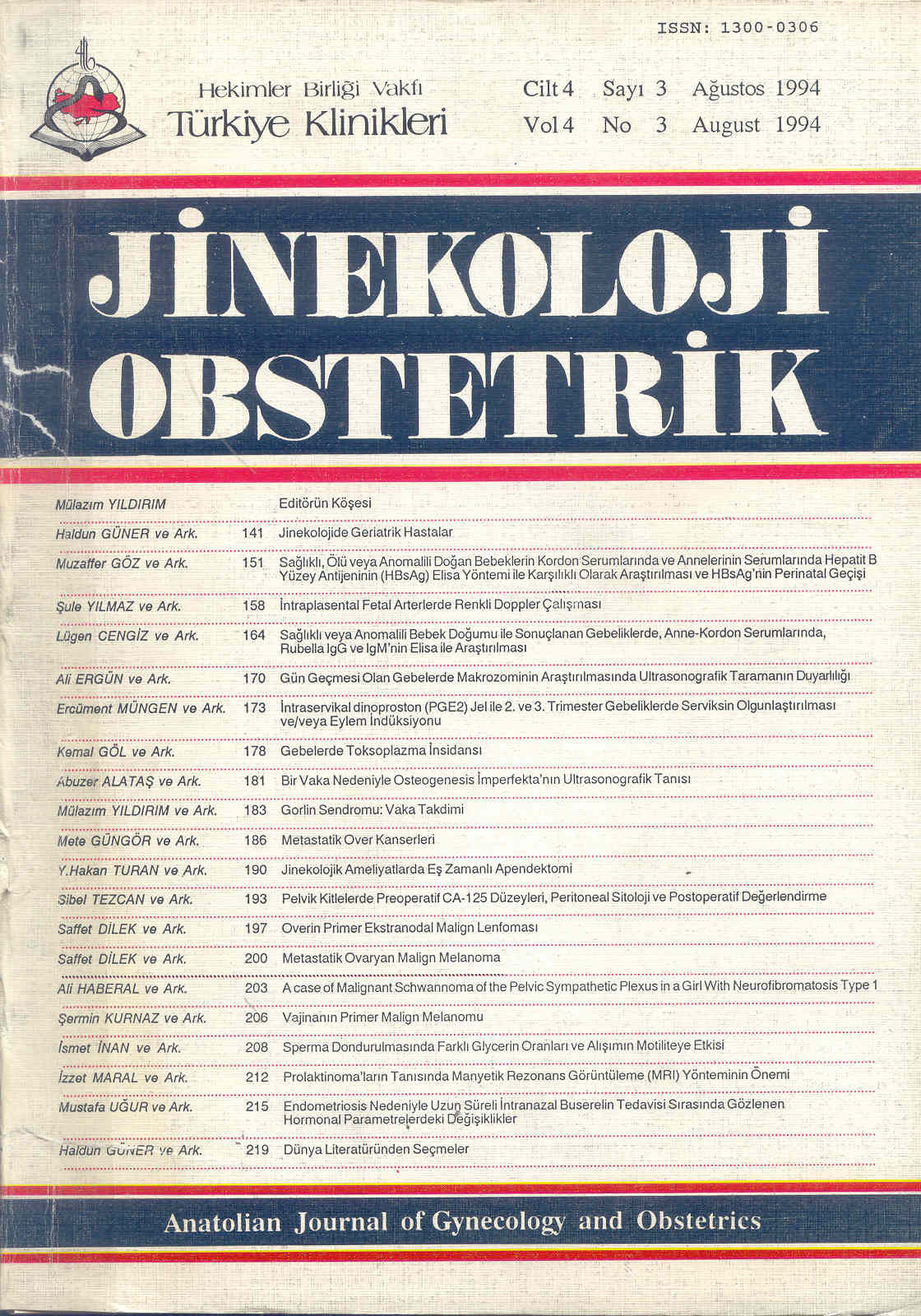Open Access
Peer Reviewed
ARTICLES
3716 Viewed1618 Downloaded
Metastatic Ovarian Cancers
Metastatik Over Kanserleri
Turkiye Klinikleri J Gynecol Obst. 1994;4(3):186-9
Article Language: TR
Copyright Ⓒ 2025 by Türkiye Klinikleri. This is an open access article under the CC BY-NC-ND license (http://creativecommons.org/licenses/by-nc-nd/4.0/)
ÖZET
Amaç: Metastatik over kanseri olgularının klinik, patolojik özellikleri ve surviv oranları açısından retrospektif olarak incelenmesi. Çalışmanın Yapıldığı Yer: Ankara Üniversitesi Tıp Fakültesi Kadın Hastalıkları ve Doğum AD. Materyal ve Metod: Ocak 1986 ile Mayıs 1993 tarihleri arasında kliniğimizde tedavi edilen 168 over kanserli hastanın 17'si (%10.1) ekstraovarial kaynaklı idi. Tüm olgular, yaş, klinik ve semptomatoloji, primer odak, tümörün gros ve histolojik özellikleri ve tedavi prosedürleri açısından değerlendirildi. Bulgular: Karşılaştırdığımız over kanseri olgularının %10.1'i metastatik idi. En sık rastlanan primer odak gastrointestinal sistem idi (%46.9). Diğerleri meme, endometrium ve akciğer idi. Sonuç: Metastatik over kanserleri, tüm over kanserleri içinde önemli bir yer tutmaktadır. Genellikle semptomatik, bilateral ve kötü prognozludur. Bu nedenle, özellikle primeri GIS ve meme olan metastatik over tümörleri, pelvik kitlelerin ayırıcı tanısında akılda tutulmalıdır.
Amaç: Metastatik over kanseri olgularının klinik, patolojik özellikleri ve surviv oranları açısından retrospektif olarak incelenmesi. Çalışmanın Yapıldığı Yer: Ankara Üniversitesi Tıp Fakültesi Kadın Hastalıkları ve Doğum AD. Materyal ve Metod: Ocak 1986 ile Mayıs 1993 tarihleri arasında kliniğimizde tedavi edilen 168 over kanserli hastanın 17'si (%10.1) ekstraovarial kaynaklı idi. Tüm olgular, yaş, klinik ve semptomatoloji, primer odak, tümörün gros ve histolojik özellikleri ve tedavi prosedürleri açısından değerlendirildi. Bulgular: Karşılaştırdığımız over kanseri olgularının %10.1'i metastatik idi. En sık rastlanan primer odak gastrointestinal sistem idi (%46.9). Diğerleri meme, endometrium ve akciğer idi. Sonuç: Metastatik over kanserleri, tüm over kanserleri içinde önemli bir yer tutmaktadır. Genellikle semptomatik, bilateral ve kötü prognozludur. Bu nedenle, özellikle primeri GIS ve meme olan metastatik over tümörleri, pelvik kitlelerin ayırıcı tanısında akılda tutulmalıdır.
ANAHTAR KELİMELER: Over kanseri, metastaz
ABSTRACT
Objective: The analysis of clinical and pathologic features and survival rates of metastatic ovarian cancers, retrospectively. Institution: Department of Obstetrics and Gynecology, Ankara University School of Medicine. Material and Methods: 17 of 168 (10.1%) ovarian cancer patient, treated in our department from January 1986 to May 1993, were of extraovarian origin. All the cases were evaluated with respect to age on presentation, clinical findings and symptoms, the origin of the primary tumor, the gross and microscopic appearances of the tumor and the treatment modality. Results: 10.1% of ovarian cancers were metastatic. The most frequently encountered primary site was gastrointestinal system (46.9%) followed by breast, endometrium and lungs, respectively. Conclusion: Metastatic ovarian cancers constitute a subgroup of ovarian cancers of profound importance. These cases are characterised to be symptomatic, with bilateral involvement and poor prognosis. For this reason, gastrointestinal system and breast should be investigated throughly, in the differential diagnosis of pelvic masses.
Objective: The analysis of clinical and pathologic features and survival rates of metastatic ovarian cancers, retrospectively. Institution: Department of Obstetrics and Gynecology, Ankara University School of Medicine. Material and Methods: 17 of 168 (10.1%) ovarian cancer patient, treated in our department from January 1986 to May 1993, were of extraovarian origin. All the cases were evaluated with respect to age on presentation, clinical findings and symptoms, the origin of the primary tumor, the gross and microscopic appearances of the tumor and the treatment modality. Results: 10.1% of ovarian cancers were metastatic. The most frequently encountered primary site was gastrointestinal system (46.9%) followed by breast, endometrium and lungs, respectively. Conclusion: Metastatic ovarian cancers constitute a subgroup of ovarian cancers of profound importance. These cases are characterised to be symptomatic, with bilateral involvement and poor prognosis. For this reason, gastrointestinal system and breast should be investigated throughly, in the differential diagnosis of pelvic masses.
MENU
POPULAR ARTICLES
MOST DOWNLOADED ARTICLES





This journal is licensed under a Creative Commons Attribution-NonCommercial-NoDerivatives 4.0 International License.










